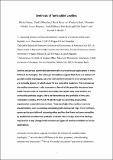Files in this item
Synthesis of ‘unfeasible’ zeolites
Item metadata
| dc.contributor.author | Mazur, Michal | |
| dc.contributor.author | Wheatley, Paul Stewart | |
| dc.contributor.author | Navarro-Rojas, Marta | |
| dc.contributor.author | Roth, Wieslaw J. | |
| dc.contributor.author | Položij, Miroslav | |
| dc.contributor.author | Mayoral, Alvaro | |
| dc.contributor.author | Eliášová, Pavla | |
| dc.contributor.author | Nachtigall, Petr | |
| dc.contributor.author | Čejka, Jiří | |
| dc.contributor.author | Morris, Russell Edward | |
| dc.date.accessioned | 2016-04-25T23:32:14Z | |
| dc.date.available | 2016-04-25T23:32:14Z | |
| dc.date.issued | 2016-01 | |
| dc.identifier | 212921706 | |
| dc.identifier | 99bb73ea-08a9-47c6-b26b-2cd54b064719 | |
| dc.identifier | 84951089346 | |
| dc.identifier | 000366675400012 | |
| dc.identifier.citation | Mazur , M , Wheatley , P S , Navarro-Rojas , M , Roth , W J , Položij , M , Mayoral , A , Eliášová , P , Nachtigall , P , Čejka , J & Morris , R E 2016 , ' Synthesis of ‘unfeasible’ zeolites ' , Nature Chemistry , vol. 8 , no. 1 , pp. 58–62 . https://doi.org/10.1038/nchem.2374 | en |
| dc.identifier.issn | 1755-4330 | |
| dc.identifier.other | ORCID: /0000-0001-7809-0315/work/61622155 | |
| dc.identifier.uri | https://hdl.handle.net/10023/8675 | |
| dc.description | R.E.M. thanks the Royal Society and the E.P.S.R.C. (Grants EP/L014475/1, EP/K025112/1 and EP/K005499/1) for funding work in this area. J.Č. and P.N. acknowledge the Czech Science Foundation for the project of the Centre of Excellence (P106/12/G015) and the European Union Seventh Framework Programme (FP7/ 2007-‐2013) under grant agreement n°604307. The research leading to these results has received funding from the European Union Seventh Framework Programme under Grant Agreement 312483 – ESTEEM2 (Integrated Infrastructure Initiative–I3). We thank Professor Wuzong Zhou and Dr. Fengjiao Yu for their expertise in TEM and Daniel Dawson for help with NMR. | en |
| dc.description.abstract | Zeolites are porous aluminosilicate materials that have found applications in many different technologies. However, although simulations suggest that there are millions of possible zeolite topologies, only a little over 200 zeolite frameworks of all compositions are currently known, of which about 50 are pure silica materials. This is known as the zeolite conundrum - why have only so few of all the possible structures been made? Several criteria have been formulated to explain why most zeolites are unfeasible synthesis targets. Here we demonstrate the synthesis of two such 'unfeasible' zeolites, IPC-9 and IPC-10, through the assembly-disassembly-organization-reassembly mechanism. These new high-silica zeolites have rare characteristics, such as windows that comprise odd-membered rings. Their synthesis opens up the possibility of preparing other zeolites that have not been accessible by traditional solvothermal synthetic methods. We envisage that these findings may lead to a step change in the number and types of zeolites available for future applications. | |
| dc.format.extent | 5 | |
| dc.format.extent | 829354 | |
| dc.language.iso | eng | |
| dc.relation.ispartof | Nature Chemistry | en |
| dc.subject | QD Chemistry | en |
| dc.subject | DAS | en |
| dc.subject | BDC | en |
| dc.subject | R2C | en |
| dc.subject.lcc | QD | en |
| dc.title | Synthesis of ‘unfeasible’ zeolites | en |
| dc.type | Journal article | en |
| dc.contributor.sponsor | EPSRC | en |
| dc.contributor.sponsor | EPSRC | en |
| dc.contributor.sponsor | EPSRC | en |
| dc.contributor.institution | University of St Andrews. School of Chemistry | en |
| dc.contributor.institution | University of St Andrews. EaSTCHEM | en |
| dc.identifier.doi | https://doi.org/10.1038/nchem.2374 | |
| dc.description.status | Peer reviewed | en |
| dc.date.embargoedUntil | 2016-04-26 | |
| dc.identifier.grantnumber | EP/K005499/1 | en |
| dc.identifier.grantnumber | EP/L014475/1 | en |
| dc.identifier.grantnumber | EP/K025112/1 | en |
This item appears in the following Collection(s)
Items in the St Andrews Research Repository are protected by copyright, with all rights reserved, unless otherwise indicated.

